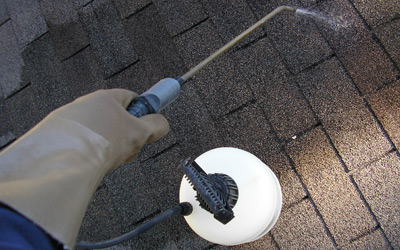Have you ever noticed black streaks or stains on a roof before? If you live in the Pacific Northwest it is likely you’ve seen these stains and may even have them on your roof. Like many other humid areas in the United States, the combination of moisture and heat is a recipe for algae growth on our roofs. In addition to algae, often times trees located close to your roof can encourage moss growth on your shingles.
Especially if you have lighter color of asphalt shingle, these black stains on your roof can become annoying and unsightly. Also, allowing moss to collect on your roof can eventually cause your shingles to rot and fail.
Read this article to learn what you can do to remove and prevent algae and moss stains on your roof. Keeping your roof looking beautiful all year long.
Image: Wikipedia Gloeocapsa magma
Moss vs. Algae
Blue-green algae (Gloeocapsa magma) commonly grows on asphalt roofs in warm and humid climates. You can generally spot the black streaks or stains easily by looking at your roof. Moss is usually green and puffy looking. Moss tends to grow on Northern  facing roofs or near trees where there is less sun exposure and more moisture.
facing roofs or near trees where there is less sun exposure and more moisture.
While both organisms can be unsightly, algae generally won’t damage your roof, where long term moss growth can eventually hurt your shingles and cause rot. Make sure to regularly inspect your roof to check for moss and algae so that you can stop any roof damage before it occurs.
Roof Cleaning Methods
The common processes to clean moss and algae from your roof is essentially the same. There are several different methods you can use which we will outline below. Some can actually be harmful to your roof and surrounding landscape unless done properly. Always use extreme caution when climbing a ladder or accessing your roof. Hire a professional with the right tools to get the job done safely and efficiently.
Pressure Washing
 Using a high power pressure washer is a sure way to remove moss and algae stains from your roof. Yet, the powerful blasts of water
Using a high power pressure washer is a sure way to remove moss and algae stains from your roof. Yet, the powerful blasts of water
also strip the important sand granules from your shingles. Greatly reducing their lifespan, effectiveness, and in some cases voiding the manufacturer warranty
If you do chose to use a pressure washer or hire a professional use one, make sure that the psi (pounds per square inch) of the washer is relatively low, around 160 psi (your average garden hose is between 40-70 psi). This will help reduce the risk of granule loss. Also, make sure to spray from the top of the shingles and down (the same direction as the normal flow of water). Spraying upwards can force water under the shingles and cause roof and shingle damage.
Preventative Chemical Treatments
Many different chemical treatments exist that claim to prevent moss and algae growth. Some shingles even come pretreated with these chemicals. While these treatments can be fairly effective, they can also be expensive and may need to be reapplied seasonally to fight moss and algae.
Zinc and Copper Strips
Zinc and copper naturally inhibit moss and algae growth. You may even notice where metal flashing and vents are located on your roof, there is little to no algae growth below. This is because the metal actually leaches into rainwater and kills moss and algae as it flows down your roof. You can recreate this throughout your entire roof by installing copper, or less expensive zinc strips, across the top of your roof.
A drawback of this method is that the metal strips can be expensive and seem to loose effectiveness after one or two seasons. Also, traces of the metals can run off onto your plants, into ponds and eventually groundwater. Potentially polluting and killing plants and animals in your yard.
Bleach Scrub Treatment
One of the most simple and cheap methods to kill and remove moss and algae is with a bleach (or other chemical) application followed by a scrub with a soft bristle brush. Sometimes chemicals like oxygen bleach, TSP (trisodium phosphate), or zinc powders can be substituted for chlorine bleach. Oxygen bleach tends to be the most environmentally friendly chemical and is still quite effective.
Use a handheld garden sprayer filled with a bleach/water solution. Spray down the stained section of the roof and let the mixture stand for 10-15 minutes. Then use a soft bristle brush to gently scrub the solution into the roof. Finally spray the roof down with a garden hose to remove the bleach, moss, and algae for a clean roof.
Image: Today’s Homeowner
Make sure to wet down plants directly below the roof to protect them from the chemical runoff. Also, remember to use extreme caution if attempting this process on your own.
A great way to keep a clean roof and stay safe is to hire your local roofer to do the job for you. If you live in the Portland metro area, give Fivecoat Roofing Inc. a call for all of your roof maintenance and installation needs. We have over 30 years of experience installing and cleaning Oregon roofs and have the right tools to get the job done quickly and safely.
Sources:
http://en.wikipedia.org/wiki/Gloeocapsa_magma
http://www.todayshomeowner.com/remove-prevent-algae-stains-asphalt-shingle/
http://www.thisoldhouse.com/toh/asktoh/question/0,,401167,00.html



